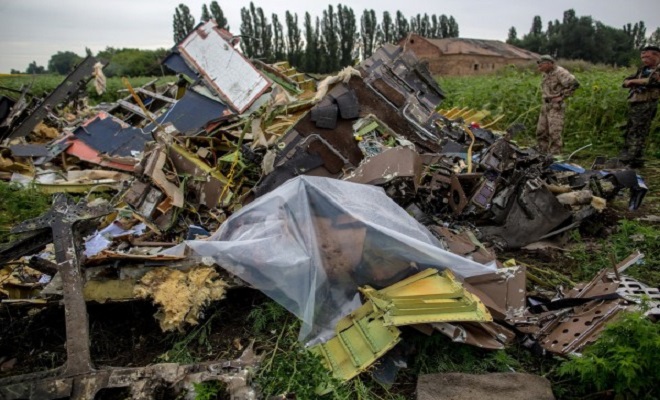 cassad-eng
cassad-eng
Featured
How the Malaysian “Boeing” was shot down
from cassad-eng:
Because since the first day after the moment of the crash of the Malaysian “Boeing” I adhere to the version where the airplane was shot down by the Ukrainian SU-25 attack jet, I simply cannot refrain from publishing a new investigation, which summarizes the arguments on this topic.
A rod from the “air-to-air” missile R-60M was found among the wreckage of MH17

A model was assembled in Holland using of the fragments of the “Boeing” that was shot down in Donetsk. Using the photos of the fragments from the crash site, it is possible to approximately reconstruct the airframe. Among the photos there were at least two that refute the version of the attack against the plane using the “BUK” complex.
On one of the photos we can see the object, which looks like a rod from the AAM missile R-60M. On the other photo — a round hole in the air intake of the right engine. There are at least nine holes in the skin that are characteristic of the effect of an “air-to-air” missile.
Circular, square, rod-shaped — what hit the Boeing
Already by the next week, on the 3rd, 5th, and 6th March of 2015, almost five thousand people — relatives and friends of those who died in the “Boeing” catastrophe in Donbass — will be able to see the model of the Malaysian Airlines Boeing-777 that is made out of wreckage on the air base Gilze-Rijen in Holland. The last major fragments, a whole truck of them, are still located in Petropavlovka – the Dutch journalists managed to reach them only by February 22 of 2015.
UPD
Photo from the hangar, 03.03.15
RECONSTRUCTION
The left side of the “Boeing”.

The right side of the “Boeing”.

The left side of the pilot cabin immediately attracted the most attention, the aircraft had the most damage there. The largest hole in the center of the fragment has ragged edges, bent outside, which is characteristic for an internal explosion or decompression due to a sharp change in pressure.
Further on the photo we see more than 20 large round holes, which penetrated among other things the glass framing and the left side of the cabin. The material of the skin in this area has the highest density — it is made of reinforced aluminum (titanium plates are used according to other data), which is laid out in two layers in order to prevent cabin damage in the case of a possible collision with a bird. According to some data, the thickness of the first layer is 1.8 mm and the thickness of the second layer is 0.8 mm.
We also know that the thickness of the most part of the skin of the fuselage of the “Boeing”-777 is only about 2 mm (0.09 inch)
As we zoom in the photos, we can see a huge number of small marks-“pockmarks” and black patches of soot on the external side of the cabin, and also the edges of the external skin that are bent inside. This suggests that the warhead exploded in close vicinity from the plane’s skin. By some estimates, the distance between the pilot cabin and the epicenter of the explosion could be between 50 cm to 4-5m. At the same time the radius of the impact zone of the “BUK” is 17 m, the missile explodes above and ahead of the target, making a climb, and creates a large cloud made of six thousand shards. (source).
Citation from mh17webtalks: Detonation products — it was precisely them which left the numerous number of traces on the cockpit fragments — lose the ability to inflict mechanical damage (lose the kinetic energy) at the distance from the site of explosion equal to 15…20 radii of the explosive block. Correspondingly, given the explosive block radius of 10–15 cm we get 1.5–3.0 m The blast wave comes first after the start of the explosion, then go the hot gases, and then, due to being more bulky, shrapnel fragments. But gas slows down very quickly, so its traces can be found only next to the site of explosion.
The “BUK” doesn’t match the photo with respect to the distance from the explosion. Well, perhaps it matches size of the holes?
















